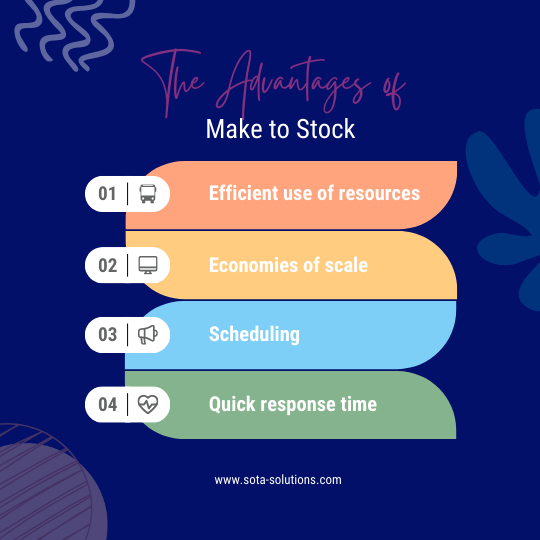"Producers manufacture commodities on a large scale in accordance with anticipated consumer demand."
In the fast-paced world of manufacturing, the Make to Stock (MTS) has historically served as a fundamental strategy for efficiently meeting customer needs. Nevertheless, as industries evolve and customer expectations continue to rise, MTS encounters numerous challenges.
This article delves into the essence of the MTS concept and examines potential issues within the MTS production system, show the pros and cons when applying MTS method into ERP system within manufacturing landscape. From demand forecasting to inventory management, this discussion aims to provide valuable insights for companies looking to tackle the complexities of MTS manufacturing accurately and adaptability.
I. What is Make to Stock(MTS)
Make to stock (MTS) is a conventional production strategy utilized by businesses to align inventory with expected consumer demand. Instead of setting a production level and subsequently trying to sell goods, a company using MTS would forecast the potential orders for its products and then supply sufficient stock to fulfill those orders.
The two keys to effective (Make to Stock) MTS planning are:
- Accurate demand forecasting
- Tools that allow quick adjustment to changing forecasts.
The MTS method will produce inventory for special occasions, items with potential surges, or essential consumer products. Therefore, the warehouse is a type of logistics facility that handles the storage and preservation of the enterprise's goods before supplying them to the market.
Developing efficient inventory management plays a crucial role in ensuring continuity and stability for the manufacturing and distribution operations of businesses using the MTS approach.
Forecasting Consumer Demand in Make-To-Stock Context:
Consumer demand predictions utilize statistical techniques such as trend analysis and regression modeling. Trend analysis leverages historical sales data and consumer trends to forecast future patterns. Regression modeling identifies correlations between demand and influencing factors like pricing and income to predict future demand levels.
However, these forecasts may not always be precise and can occasionally be misleading. Shifting consumer preferences and unforeseen events can result in inaccurate demand predictions, leading to excess inventory and financial losses.
Consequently, manufacturers, distributors, and retailers must devise detailed production and distribution schedules to ensure that finished goods are available in stores at the right time to meet customer demand.
II. Advantages of Make To Stock (MTS)
One of key advantages of the make-to-stock (MTS) production strategy is the ability to produce inventory based on anticipated consumer demand. MTS enables a company to avoid the problem of excessive or insufficient inventory levels. Here are some detailed advantages of Make to Stock approach:

- Resource Optimization: Production is meticulously planned based on anticipated demand, ensuring optimal resource utilization and operational efficiency.
- Leveraging Economies of Scale: By manufacturing goods at a large scale, fixed production costs are spread across a greater number of units. This lowers the average production cost per unit and enables businesses to capitalize on economies of scale.
- Streamlined Scheduling: Precise decisions regarding production timing and volume are made well in advance. This allows for smooth workflow execution according to a predetermined schedule, with real-time visibility into remaining tasks.
- Enhanced Responsiveness: Finished goods are readily available for immediate purchase, enabling customers to select and take delivery of products promptly from the shop.
III. Disadvantages of Make To Stock (MTS)
The disadvantages of make to stock include the following: Unpredictable Consumer Trends - While manufacturers using a make-to-order strategy will also struggle with unpredictable customer trends, this is something that must be considered when using a make-to-stock strategy. Let's dig deeper into the disadvantages of the MTS strategy:

Challenges with Forecasting Accuracy: Forecasts of consumer demand can be misleading at times. For instance, sales might unexpectedly decline during a projected peak season due to external factors like a recession. Conversely, demand could surge unexpectedly during an anticipated slow season.
Management of Inventory Levels: Despite diligent forecasting, inventory levels may consistently fall short or remain excessively high.
Fluctuating Consumer Preferences: Production quantities are determined based on anticipated demand, yet consumer preferences and trends are constantly evolving. This poses a risk of inventory wastage due to product obsolescence.
Leave us a message!